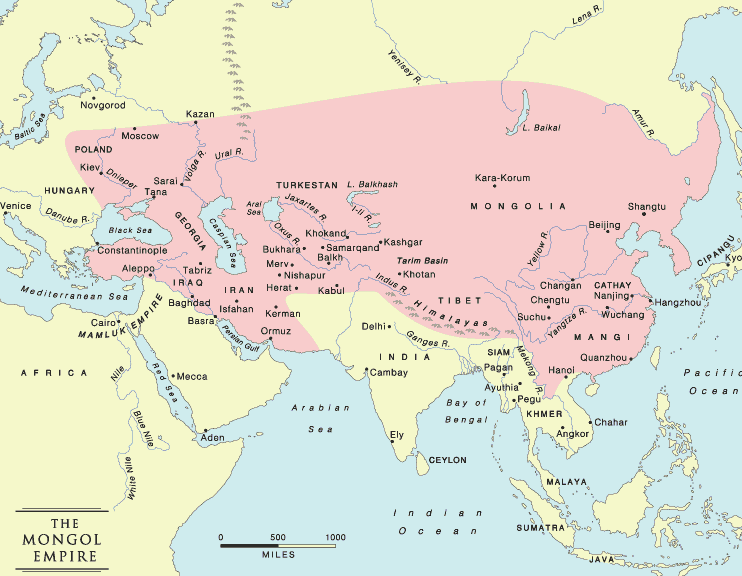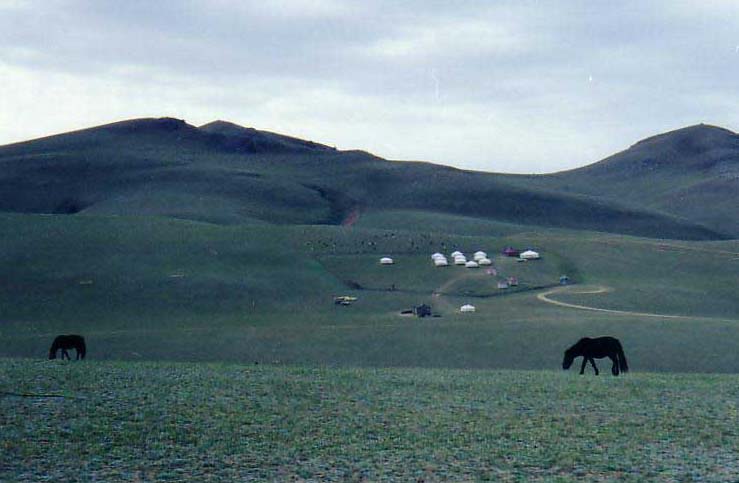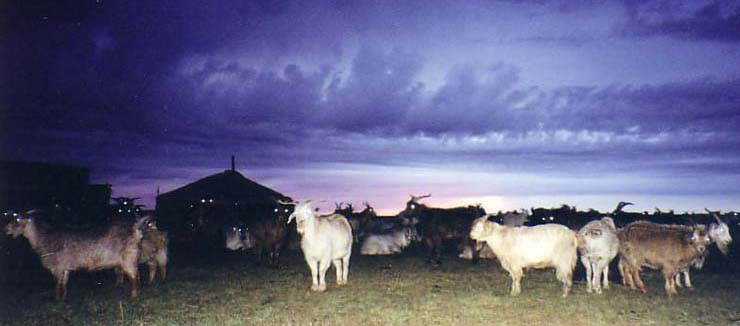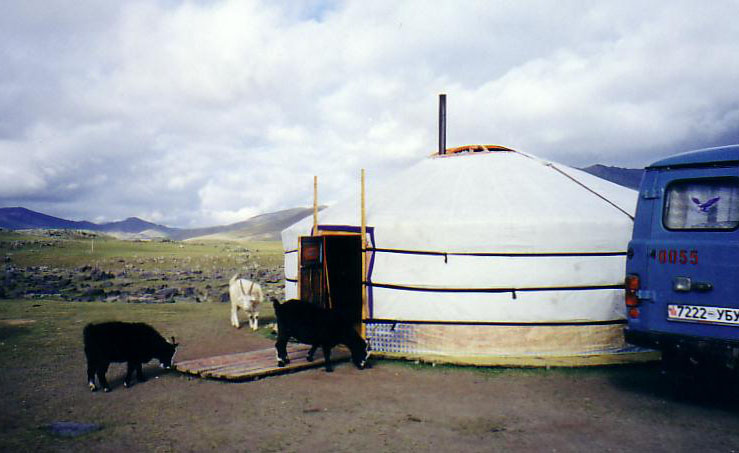 |
|||||||||||||||||||||||||||||||||||||||||||||||||||||
|
about Mongolia:
The Story of the Weeping Camel - National Geographic JJulia Roberts in Mongolia - Nature, PBS.org MMongols Go From Camels to Jeeps and a Superhighway - The New York Times TThe Man Who Would Be Khan - The Atlantic Monthly Throat Singing, and other music files and links |
|||||||||||||||||||||||||||||||||||||||||||||||||||||
|
Archeological digs have uncovered human remains in the Gobi and other regions of Mongolia dating back nearly 500,000 years. Despite Mongolia's short summers, wheat growing has co-existed for thousands of years with nomadic herding, which the Mongols took up after they tamed horses, yaks and camels. The name 'Mongol' was first recorded by the Chinese during the Tang dynasty (618-907 AD). At that time Mongolia was dominated by a Turkic people called the Uighurs. The Uighurs were influenced by Christianity and, after taking control of Mongolia, went on to save the ailing Tang rulers of China from an internal revolt. The Uighurs controlled most of Mongolia until 840 AD, when they were defeated by the Kyrgyz, who now live in the Chinese province of Xinjiang. ...The Largest Empire the World Has Ever Known: They remained little more than a loose confederation of rival clans until the late 12th century, when a 20 year old Mongol named Temujin emerged and managed to unite most of the Mongol tribes. In 1189 he was given the honorary name of Genghis Khan, meaning 'universal king'. The Genghis Khan imprinted in the memory of the west bears little relation to the Chinggis Khaan revered by Mongolians. Not only is the spelling different: to Europeans, the name epitomizes mercilessness and warmongering; to the Mongolians, it embodies strength, unity, law and order. Genghis set up his capital in present-day Kharkhorin, and launched his important cavalry - built on Mongolia's prized takhi horses - against China and Russia. By the time of his death in 1227, the Mongol empire extended from Beijing to the Caspian Sea. |
|||||||||||||||||||||||||||||||||||||||||||||||||||||
| Mongolia Facts:
Area: 1,566,000 sq km (610,740 sq mi) |
|||||||||||||||||||||||||||||||||||||||||||||||||||||
|
reached the limits of its expansion. Instead of looking for more wars to fight, he concentrated on keeping the vast empire together. This was the height of the Mongols' glory: the empire stretched from Korea to Hungary and as far south as Vietnam, making it the largest empire the world has ever known... lonelyplanet.com/destinations/north_east_asia/mongolia |
|||||||||||||||||||||||||||||||||||||||||||||||||||||
 |
|||||||||||||||||||||||||||||||||||||||||||||||||||||
|
|
|||||||||||||||||||||||||||||||||||||||||||||||||||||
| Genghis Khan a Prolific Lover, DNA Data Implies -
Genghis Khan, the fearsome Mongolian warrior of the 13th century, may have done more than rule the largest empire in the world; according to a recently published genetic study, he may have helped populate it too. An international group of geneticists studying Y-chromosome data have found that nearly 8 percent of the men living in the region of the former Mongol empire carry y-chromosomes that are nearly identical. That translates to 0.5 percent of the male population in the world, or roughly 16 million descendants living today. ...read more from National Geographic News, (February 14, 2003) |
|||||||||||||||||||||||||||||||||||||||||||||||||||||
|
|
|||||||||||||||||||||||||||||||||||||||||||||||||||||
 |
|||||||||||||||||||||||||||||||||||||||||||||||||||||
|
|
|||||||||||||||||||||||||||||||||||||||||||||||||||||
| A comparison of Mongolia to Montana and Wyoming:
Here is an attempt at a comparative employment table for Montana and Mongolia in 1998, from several statistical sources - see the Sources list. Definitions and categories are not fully comparable. The table emphasises the huge gap between a poor agricultural country, and a rich service-based economy. But it is not possible, to simply swop the jobs in agriculture for jobs in services. If it was so easy, Africa would be a rich continent. Much employment in the USA is in the kind of jobs which provide growing Montana's job growth: retail sales, child care, waitresses, cashiers, cleaners, nurses, food preparation workers and secretaries. But that service economy is dependent on other high-productivity jobs, including those in industry. In theory Mongolians can employ each other, to sell options on their sheep: but that will never generate the incomes of US options brokers. [!] |
|
||||||||||||||||||||||||||||||||||||||||||||||||||||
|
|
|||||||||||||||||||||||||||||||||||||||||||||||||||||
| Economy - overview: Economic activity traditionally has been based on agriculture and breeding of livestock. Mongolia also has extensive mineral deposits: copper, coal, molybdenum, tin, tungsten, and gold account for a large part of industrial production. Soviet assistance, at its height one-third of GDP, disappeared almost overnight in 1990-91, at the time of the dismantlement of the USSR. Mongolia was driven into deep recession, prolonged by the Mongolian People's Revolutionary Party's (MPRP) reluctance to undertake serious economic reform. The Democratic Coalition (DC) government has embraced free-market economics, easing price controls, liberalizing domestic and international trade, and attempting to restructure the banking system and the energy sector. Major domestic privatization programs were undertaken, as well as the fostering of foreign investment through international tender of the oil distribution company, a leading cashmere company, and banks. Reform was held back by the ex-Communist MPRP opposition and by the political instability brought about through four successive governments under the DC. Economic growth picked up in 1997-99 after stalling in 1996 due to a series of natural disasters and declines in world prices of copper and cashmere. In August and September 1999, the economy suffered from a temporary Russian ban on exports of oil and oil products, and Mongolia remains vulnerable in this sector. Mongolia joined the World Trade Organization (WTrO) in 1997. The international donor community pledged over $300 million per year at the last Consultative Group Meeting, held in Ulaanbaatar in June 1999. The MPRP government, elected in July 2000, is anxious to improve the investment climate; it must also deal with a heavy burden of external debt. Falling prices for Mongolia's mainly primary sector exports, widespread opposition to privatization, and adverse effects of weather on agriculture in early 2000 and 2001 restrained real GDP growth in 2000-01. [http://www.cia.gov/cia/publications/factbook/geos/mg.html] |
|||||||||||||||||||||||||||||||||||||||||||||||||||||
 |
|||||||||||||||||||||||||||||||||||||||||||||||||||||
| The vast expanses of the steppes, the absolute magnitude, beauty and wonder of the Mongolian scenery are intertwined with the Mongolian nomadic lifestyle and renowned hospitality which has little changed [with] the passing of the time. The Mongolian culture is shaped by nomadism and the traditional dwelling of the nomadic Mongolian, the ger, is the focal point of many customs and traditions... (Visit Mongolia http://www.visit2003.mn/info/index.html) |
|||||||||||||||||||||||||||||||||||||||||||||||||||||
 |
|||||||||||||||||||||||||||||||||||||||||||||||||||||
 |
Why I love mutton... by Rioko Imaoka, Osaka University I had enough clothes on me, but not enough for the huge refrigerator Mongolia turns into in winter." I begun to feel cold sneaking inside me, and my stomach began to miss the fatty lamb I was offered to take on the road. The local lamb turned to be magic and warmed me up more than any modern clothes. |
||||||||||||||||||||||||||||||||||||||||||||||||||||
|
|
|||||||||||||||||||||||||||||||||||||||||||||||||||||
|
mp3 files:
Mongolian throat singing 1 (634 KB) Tuva throat singing - Shamanic prayer (2364 KB) Mongolian throat singing 2 (6,721 KB) Yat-Kha - Solun Chaagai Sovet Churtum (7116 KB) Yat-Kha - Chashpy-Khem (6043 KB) Huun Huu Tur - Far from Tuva (1818 KB) |
|||||||||||||||||||||||||||||||||||||||||||||||||||||
|
additional links:
The Colorado Yurt Company Google language tools Bunker Mentality | The Front Page golfer | www.pmfgolfguide.com |
|||||||||||||||||||||||||||||||||||||||||||||||||||||
|
|
|||||||||||||||||||||||||||||||||||||||||||||||||||||
